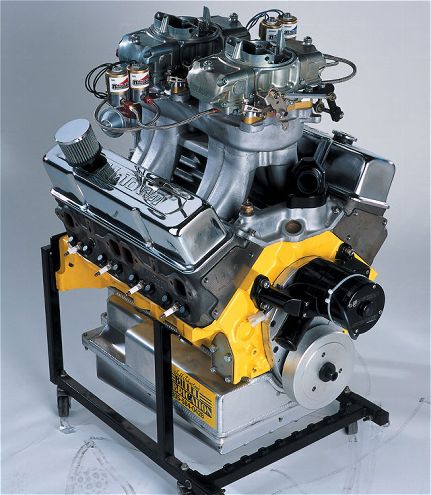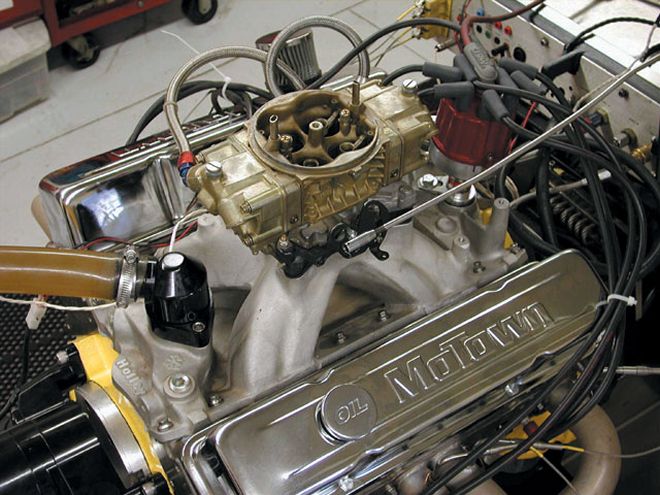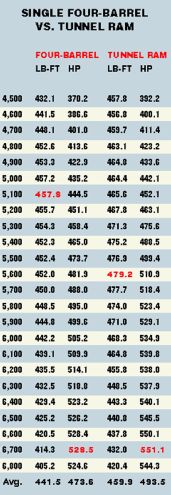

Man, ya just can't know the feeling until you're standing there: a few whacks of the throttle, then a blip of the nitrous button at about 3,500 rpm to purge the air from the feed line. The engine leaps violently, practically knocking over the dyno stand as the torque spikes dead vertical. Then finally--ha-ha!--a full pull, the SuperFlow claims 872 hp, and there's no parts on the floor. Nothin' like it.
Keep in mind we're talking about a mere 359 ci, the displacement of our long-term thrasher small-block Chevy, and it only has 10.0:1 compression. See the sidebar for the most current specs. Last month we threw a big cam and a set of World Products 220cc-intake-runner Motown heads on the Anvil, then got all whiny and girly about the low-end torque we lost in exchange for a respectable 530 hp at the top. As promised, there are no excuses this month. We've embraced the power quest and finally flogged the Anvil's stout rotating assembly to its original intent.


Last Month
528.5 hp @ 6,700
457.8 lb-ft @ 5,100
To review, last month the Anvil was treated to the same Motown 220cc heads and Lunati solid-lifter cam described in the "872hp Anvil Specs" sidebar. However, back then we ran it with two different intake combos: a Holley Street Dominator dual-plane with a 750-cfm Street Avenger carb, then a Holley Strip Dominator single-plane and a Holley 830-cfm double-pumper carb. It was the latter that put up the big numbers, making nearly 530 hp. However, since the dual-plane combo was plumbed for an NOS Sportsman Fogger, we also checked that out and made 720 peak horsepower with jetting of 0.028 nitrous/0.032 fuel, 7 pounds of fuel pressure, and 1,100 pounds of bottle pressure. Fun, but not fun enough.
Tunnel-Ram Swap
551.1 hp @ 6,700 rpm
479.2 lb-ft @ 5,600 rpm
Tunnel rams may be icons of the hole-in-the-hood '70s, but you can't say they don't make big power. This month we stacked the Anvil with an Edelbrock Street Tunnel ram, with longer, smaller ports than a full-competition tunnel ram, then added a pair of Speed Demon 650-cfm mechanical-secondary carbs that were ultimately jetted at 94/96 with no power valves. Ignition timing for optimal peak power was 40 degrees total.
We only made power pulls above 4,500 rpm--that's just below where you'd want the torque converter to stall with this engine--but it's clear that the tunnel ram whacked the wee out of the single four- barrel at every point along the way to a screamin' 550-plus horsepower at 6,700 rpm. On average from 4,500 to 6,800, the dual fours killed the single quad by 18 lb-ft and 20 hp. The rpm at peak power did not change, though the number grew by 22.6 horses. Interestingly, the rpm at peak torque climbed from 5,100 to 5,600 rpm. But consider this: The tunnel ram may reach its torque peak at 500 rpm higher than the four-barrel, but at the four-barrel's peak of 5,100 rpm, the tunnel ram is still making an extra 7.8 lb-ft. If you care to trust the Mr. Gasket Drag2000 computer simulation, an optimized combo would see about a tenth and a half difference at the dragstrip when comparing the four-barrel to the tunnel ram. Seems fair. It also claims that a 3,400-pound car could run 10.80s with the tunnel ram setup, a 5,000-rpm stall, 4.56 gears, and 30x12.50 slicks. Seems optimistic.
Regardless, tunnel rams are cool. But watch what happens next.
Twin Nitrous Works Plate Systems
872 hp @ 6,300 rpm
726 lb-ft @ 6,300 rpm
Oooh, yeah ... nitrous good. Nitrous violent. Stepping to the plate in a big way, we slipped a Nitrous Works Billet Atomizer setup under each of the twin Speed Demons and jetted 'em at 150 hp apiece. Barry Grant's Nitrous Works offers nitrous-kit solenoids in three sizes: Sportsman, Pro, and (for fuel only) Magnum. This setup used a pair of the Pro clickers for each plate, and we fed them with -6 line on the nitrous side and 7 psi of fuel on the other. Sadly, our nitrous supply ran low, giving us only 900 psi of bottle pressure for the glory run; that made the engine fuel-rich with the nitrous engaged, and while lean conditions are the last thing in the world you want on a nitrous combo, a rich mixture eats power in a hurry. Detonation holds hands with lean-out when it comes to killing engines, so we loaded the fuel tank with 76 Performance Products' 114-octane race fuel and rolled the ignition timing back to 24 degrees total. We felt confident that the Lunati bottom end and Motown block would spit the power back without flinching as long as we did nothing stupid.
The reward was 321 extra horsepower--consistent with the estimated 300-horse jetting spec from Nitrous Works. As with most nitrous dyno pulls we'd seen, the power curve stood plumb vertical when the button was hit, then followed a slight downward curve as rpm climbed. Power peak is almost always a few hundred rpm after you engage the nitrous, which is why we saw 872 hp at 6,300 rpm rather than the engine's no-nitrous peak of 6,700. It's also why the torque peak is at the same rpm as the horsepower peak.
Now we're looking at 8s in a properly setup car, and this is an engine that can still be driven around town on premium pump gas.
What's Next?
Followers of the Anvil series have noted bigger and bigger power with each installment. So what could follow 872 hp? Supercharger? Turbo? That stuff's down the road, but there's another option that will take us a few months to sort out, so expect a brief hiatus from Anvil stories. But when it comes back, it'll be really tasty; something Hot Rod hasn't messed with in a long, long time. Hint: It's gonna make our eyes water.